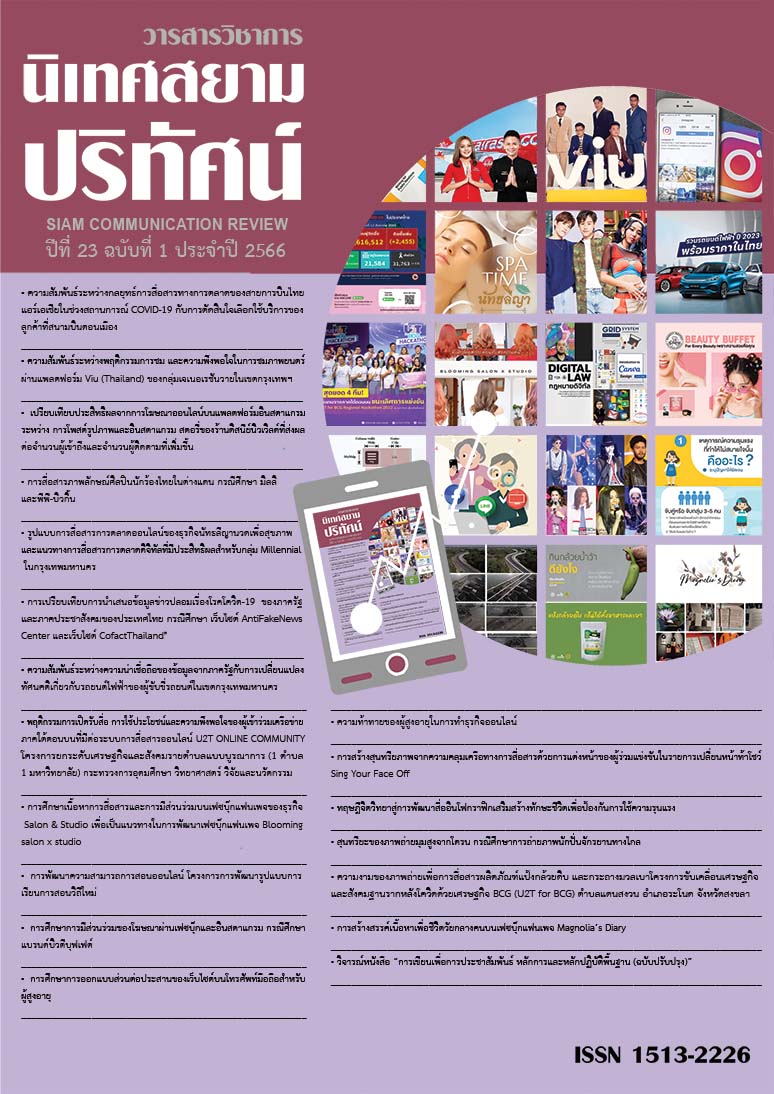Design Studies of Smartphone Website Interface Design for Older Adults
Main Article Content
Abstract
Smartphones are now being used by all segments of the population, including the elderly. Smartphones have undeniably made life easier. however, due to physical deterioration in the elderly, such as vision, hearing, and various movements, the use of websites on smartphones is severely limited. With a smaller screen and different needs than normal people, the style and size of the text, color contrast, size and position of the buttons, etc., are all important and help older people use the website more easily. In this article, the various research on smartphone user interface design and web design guidelines for the elderly is reviewed to conclude that mobile web design guidelines for the elderly are based on various research and make it easier for the elderly to access the information they need. It also avoids errors and reduces the burden on older people. The way a website is designed on a smartphone for the elderly can be applied in practice and is useful for interface designers who want to design website interfaces on mobile screens or can apply this approach to other screens.
Article Details

This work is licensed under a Creative Commons Attribution-NonCommercial-NoDerivatives 4.0 International License.
References
ณัชชา ปาพรม. (2561). การศึกษาและพัฒนาแอพพลิเคชั่นการเตรียมความพร้อมทางร่างกาย สำหรับผู้ที่กำลังเข้าสู่สังคมสูงอายุ. วิทยานิพนธ์ปริญญามหาบัณฑิต, สาขาวิชาศิลปกรรม คณะศิลปกรรมศาสตร์ มหาวิทยาลัยศรีนครินทรวิโรฒ.
ทิพยา จินตโกวิท และศจีมาจ ณ วิเชียร. (2562). แนวทางการออกแบบเว็บไซต์ด้านสุขภาพสำหรับผู้สูงอายุ. วารสารวิชาการครุศาสตร์อุตสาหกรรม พระจอมเกล้าพระนครเหนือ, 10(1), 217.
ธิติพร ชาญศิริวัฒน์ และสมาน ลอยฟ้า. (2560). รูปแบบการนำเสนอเว็บที่ผู้สูงอายุสามารถเข้าถึงได้ กรณีศึกษาผู้สูงอายุจังหวัดอุบลราชธานี. วารสารวิชาการมหาวิทยาลัยฟาร์อีสเทอร์น, 11(3), 276–276.
มูลนิธิสถาบันวิจัยและพัฒนาผู้สูงอายุไทย. (2563). รายงานสถานการณ์ผู้สูงอายุไทย ปี 2562. เข้าถึงได้จาก https://thaitgri.org/?p=39387
รัตนโชติ เทียนมงคล. (2560). การศึกษาลักษณะฟอนต์ที่เหมาะสมต่อประจักษ์ภาพสำหรับผู้สูงวัย ในบริบทตัวอักษรไทยบนหน้าจอแท็บเล็ตคอมพิวเตอร์. Veridian E-Journal,Silpakorn University (Humanities, Social Sciences and Arts), 10(3)1066–1082.
วิชญ์พล เกตุชัยโกศล. (2559). การศึกษาขนาดของปุ่มที่เหมาะสมในโมบายแอพพลิเคชั่นสำหรับผู้สูงอายุ. วิทยานิพนธ์ปริญญามหาบัณฑิต, สาขาวิชาเทคโนโลยีสารสนเทศและการจัดการ มหาวิทยาลัยกรุงเทพ.
สุชาดา วีระกุลพิริยะ. (2563). ลักษณะตัวอักษรไทยที่พึงประสงค์ต่อการอ่านบนเว็บไซต์ของผู้สูงอายุ. วิทยานิพนธ์ปริญญามหาบัณฑิต, สาขาวิชาเทคโนโลยีสารสนเทศ สำนักวิชาเทคโนโลยีสังคม มหาวิทยาลัยเทคโนโลยีสุรนารี.
Bozarth, Rebecca Joy. (2021). Eldre65: Creating a Website for Senior Adults Based Upon User Experience. Masters of Fine Arts (Graphic Design). Virginia. Liberty University.
Duangpatra, Patana., Bunchoo Bunlikhitsiri, & Peera Wongupparaj. (2021). “The Competency in Using Smartphones of the Homebound Older Adult.” International Journal of Interactive Mobile Technologies (IJIM). 15(09):136–53. doi: 10.3991/ijim.v15i09.20885.
Kamtab, Parwapun, &Theerapong Wiriyanon. (2022). Design a digital multimodal user interface for senior citizens. Journal of Education Studies Chulaongkorn University, 50(1), 1-13.
Kelly, Eve., Michelle Weech, Rosalind Fallaize, Rodrigo Zenun Franco, Faustina Hwang, & Julie Lovegrove (2021). Designing Apps to Support Engagement by Older Adults: A Think-Aloud Study of the ENutri Dietary-Intake Assessment Web App. In The 23rd International ACM SIGACCESS Conference on Computers and Accessibility, pp. 1–3. New York, USA: Association for Computing Machinery.
Li, Qingchuan., & Yan Luximon. (2019). Older Adults’ Use of Mobile Device: Usability Challenges While Navigating Various Interfaces. Behaviour & Information Technology, 39, 1–25. doi: 10.1080/0144929X.2019.1622786.
Navabi, Nasrin., Fatemeh Ghaffari, & Zahra Jannat-Alipoor. (2016). Older Adults’ Attitudes and Barriers toward the Use of Mobile Phones. Clinical Interventions in Aging, 11, 1371–1378. doi: 10.2147/CIA.S112893.
Punchoojit, Lumpapun., & Nuttanont Hongwarittorrn. (2017). Usability Studies on Mobile User Interface Design Patterns: A Systematic Literature Review. Advances in Human-Computer Interaction, 2017, 1–22. doi: 10.1155/2017/6787504.
Wilson, Samantha A., Paula Byrne, Sarah E. Rodgers, & Michelle Maden. (2022). A Systematic Review of Smartphone and Tablet Use by Older Adults With and Without Cognitive Impairment. Innovation in Aging, 6(2), igac002. doi: 10.1093/geroni/igac002.
Google. (2022). Material Design. Retrieved from https://material.io/design/usability/accessibility.html#layout-and-typography
United Nations. (2020). World Population Ageing 2020 Highlights: Living Arrangements of Older Persons. Retrieved from https://www.un.org/development/desa/pd/sites/www.un.org.development.desa.pd/files/undesa_pd-2020_world_population_ageing_highlights.pdf


